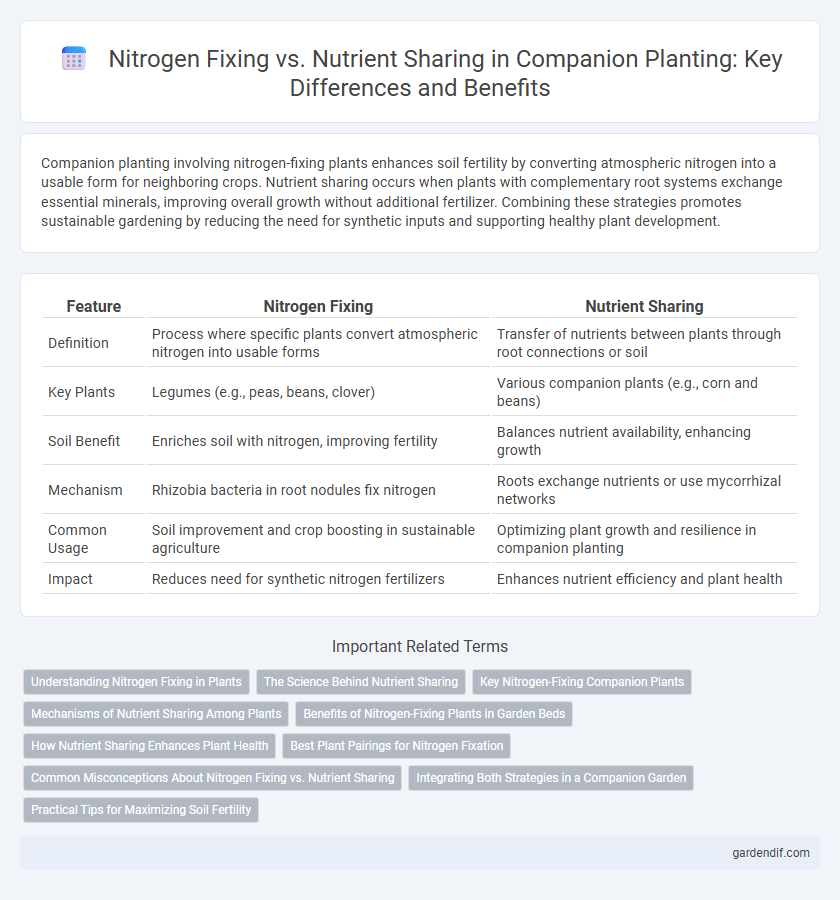
Nitrogen fixing vs nutrient sharing Illustration
Companion planting involving nitrogen-fixing plants enhances soil fertility by converting atmospheric nitrogen into a usable form for neighboring crops. Nutrient sharing occurs when plants with complementary root systems exchange essential minerals, improving overall growth without additional fertilizer. Combining these strategies promotes sustainable gardening by reducing the need for synthetic inputs and supporting healthy plant development.
Table of Comparison
| Feature | Nitrogen Fixing | Nutrient Sharing |
|---|---|---|
| Definition | Process where specific plants convert atmospheric nitrogen into usable forms | Transfer of nutrients between plants through root connections or soil |
| Key Plants | Legumes (e.g., peas, beans, clover) | Various companion plants (e.g., corn and beans) |
| Soil Benefit | Enriches soil with nitrogen, improving fertility | Balances nutrient availability, enhancing growth |
| Mechanism | Rhizobia bacteria in root nodules fix nitrogen | Roots exchange nutrients or use mycorrhizal networks |
| Common Usage | Soil improvement and crop boosting in sustainable agriculture | Optimizing plant growth and resilience in companion planting |
| Impact | Reduces need for synthetic nitrogen fertilizers | Enhances nutrient efficiency and plant health |
Understanding Nitrogen Fixing in Plants
Nitrogen fixing in plants involves specialized bacteria, such as Rhizobium, establishing symbiotic relationships with leguminous plants to convert atmospheric nitrogen into ammonia, a form accessible for plant uptake. This biological process enriches soil nitrogen content naturally, reducing the need for synthetic fertilizers and promoting sustainable agriculture. Unlike nutrient sharing, which involves the exchange of various nutrients through root systems or mycorrhizal networks, nitrogen fixing specifically addresses atmospheric nitrogen conversion, directly enhancing plant growth and soil fertility.
The Science Behind Nutrient Sharing
Nitrogen fixing bacteria convert atmospheric nitrogen into forms plants can absorb, directly enhancing soil fertility in companion planting systems. Nutrient sharing involves root exudates and mycorrhizal networks that facilitate the transfer of essential minerals like phosphorus and potassium between plants. This symbiotic exchange boosts overall nutrient availability and supports plant growth more efficiently than nitrogen fixation alone.
Key Nitrogen-Fixing Companion Plants
Key nitrogen-fixing companion plants such as clover, alfalfa, and peas enhance soil fertility by converting atmospheric nitrogen into forms accessible to surrounding crops. These plants establish symbiotic relationships with Rhizobium bacteria, increasing nitrogen availability and reducing the need for synthetic fertilizers. Nutrient sharing complements nitrogen fixation by facilitating the exchange of minerals like phosphorus and potassium among companion plants, promoting overall soil health and crop productivity.
Mechanisms of Nutrient Sharing Among Plants
Plants engage in nutrient sharing through mycorrhizal networks, where fungal hyphae connect root systems, facilitating the transfer of nitrogen, phosphorus, and other essential nutrients. Nitrogen-fixing bacteria in root nodules convert atmospheric nitrogen into ammonia, providing bioavailable nitrogen directly to host plants, while neighboring plants benefit indirectly via shared resources in the rhizosphere. These symbiotic relationships optimize nutrient uptake efficiency and promote ecosystem productivity by enhancing nutrient cycling among plant companions.
Benefits of Nitrogen-Fixing Plants in Garden Beds
Nitrogen-fixing plants, such as legumes, enhance soil fertility by converting atmospheric nitrogen into a usable form, reducing the need for synthetic fertilizers. This natural process promotes robust plant growth and improves yields by supplying essential nutrients to neighboring plants in garden beds. Incorporating nitrogen-fixing companions fosters sustainable gardening practices while maintaining balanced nutrient cycles.
How Nutrient Sharing Enhances Plant Health
Nutrient sharing between companion plants enhances plant health by facilitating the transfer of essential minerals, vitamins, and organic compounds through root exudates and mycorrhizal networks. This biological synergy improves soil fertility and nutrient availability, promoting stronger root systems, increased resistance to diseases, and better stress tolerance. Unlike nitrogen fixing, which specifically enriches soil with nitrogen, nutrient sharing provides a more comprehensive array of nutrients that support overall plant growth and ecosystem stability.
Best Plant Pairings for Nitrogen Fixation
Leguminous plants like clover, peas, and beans excel at nitrogen fixation by converting atmospheric nitrogen into a form usable by plants, enriching the soil naturally. Pairing nitrogen-fixing plants with heavy feeders such as corn, tomatoes, or brassicas enhances nutrient availability and boosts growth through effective nutrient sharing. Optimal companion planting maximizes soil fertility and plant health by leveraging the natural symbiotic relationships between nitrogen-fixing species and nutrient-demanding crops.
Common Misconceptions About Nitrogen Fixing vs. Nutrient Sharing
Common misconceptions about nitrogen fixing versus nutrient sharing often confuse the two distinct processes: nitrogen fixing involves symbiotic bacteria converting atmospheric nitrogen into ammonia for plant use, while nutrient sharing refers to the transfer of various minerals and organic compounds between companion plants through root interactions or mycorrhizal networks. Many assume nitrogen fixing alone significantly boosts overall soil fertility, but nutrient sharing plays an equally crucial role in balancing soil nutrients and enhancing plant health. Understanding these differences is essential for optimizing companion planting strategies and sustainable agriculture.
Integrating Both Strategies in a Companion Garden
Integrating both nitrogen-fixing and nutrient-sharing plants in a companion garden enhances soil fertility and plant health by creating a balanced ecosystem. Nitrogen-fixing legumes convert atmospheric nitrogen into forms usable by surrounding plants, while nutrient-sharing species improve the bioavailability of phosphorus and micronutrients. This synergy optimizes nutrient cycling, reduces fertilizer dependency, and promotes sustainable, high-yield organic gardening.
Practical Tips for Maximizing Soil Fertility
Nitrogen fixing plants like legumes convert atmospheric nitrogen into forms accessible to crops, enhancing soil fertility naturally. Nutrient sharing involves planting complementary species that exchange nutrients through root systems or mycorrhizal networks, optimizing resource use. To maximize soil fertility, interplant nitrogen fixers with nutrient-sharing companions, maintain diverse crop rotations, and incorporate organic matter to support microbial activity.
Nitrogen fixing vs nutrient sharing Infographic

 gardendif.com
gardendif.com